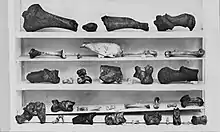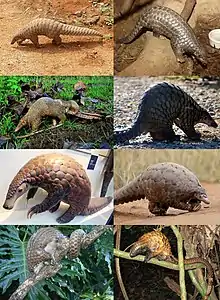Manis palaeojavanica
Giant asian pangolin (Manis palaeojavanica ["ancient Javan pangolin"]), is an extinct species of pangolin (from genus Manis) native to Asia.[5]
| Manis palaeojavanica Temporal range: late Pleistocene | |
|---|---|
 | |
| bones of Manis palaeojavanica (darker) compared to same bones of Manis javanica (lighter) | |
| Scientific classification | |
| Kingdom: | Animalia |
| Phylum: | Chordata |
| Class: | Mammalia |
| Order: | Pholidota |
| Family: | Manidae |
| Genus: | Manis |
| Subgenus: | Paramanis |
| Species: | †M. palaeojavanica |
| Binomial name | |
| †Manis palaeojavanica Dubois, 1907[1] | |
| Synonyms | |
In 1926, E. Dubois described the bones of M. palaeojavanica discovered in Java. Later, Lord Medway excavated another set of bones at the Niah Caves in Malaysia. In 1960, D. A. Hoojier identified these bones as that of an extinct species. Using carbon dating, the Niah Caves bones were determined to be 42,000–47,000 years old.[6]
M. palaeojavanica is one of the only known fossils to be found nearly complete of the pangolin species, due to their armour-like scales that protected their bodies when they were alive.[7]
Phylogeny
Phylogenetic position of Manis palaeojavanica within family Manidae.[8][9][10]
| Pholidotamorpha |
| |||||||||||||||||||||||||||||||||||||||||||||||||||||||||||||||||||||||||||||||||||||||||||||
(Pholidota sensu lato) |
References
- Dubois, E. (1907.) "Eenige van Nederlandschen kant verkregen uitkomsten met betrekking tot de kennis der Kendeng-fauna (Fauna van Trinil)." Tijdschr. Kon. Ned. Aardr. Gen., Serie 2 (24):449-458
- Dubois, E. (1908.) "Das Geologische Alter der Kendengoder Trinil-Fauna." Tijdschr. Kon. Ned. Aardr. Gen., Serie 2 (25):1235-1270, pl. 39.
- Max Weber (1928.) "Die Säugetiere", vol. 2, Jena, p. 185
- Raven, Henry Cushier (1935.) "Wallace's line and the distribution of Indo-Australian mammals." Bulletin of the AMNH; v. 68, article 4
- John C. Barentine (2016). Uncharted Constellations: Asterisms, Single-Source and Rebrands. Springer. p. 186. ISBN 978-3-319-27619-9.
- Quentin Phillipps; Karen Phillipps (2016). Phillipps' Field Guide to the Mammals of Borneo and Their Ecology: Sabah, Sarawak, Brunei, and Kalimantan. Princeton University Press. p. 153. ISBN 978-0-691-16941-5.
- Gaudin, Timothy J.; Emry, Robert J.; Wible, John R. (December 2009). "The Phylogeny of Living and Extinct Pangolins (Mammalia, Pholidota) and Associated Taxa: A Morphology Based Analysis". Journal of Mammalian Evolution. 16 (4): 235–305. doi:10.1007/s10914-009-9119-9. ISSN 1064-7554. S2CID 1773698.
- Gaudin, Timothy (2009). "The Phylogeny of Living and Extinct Pangolins (Mammalia, Pholidota) and Associated Taxa: A Morphology Based Analysis" (PDF). Journal of Mammalian Evolution. Heidelberg, Germany: Springer Science+Business Media. 16 (4): 235–305. doi:10.1007/s10914-009-9119-9. S2CID 1773698.
- Kondrashov, Peter; Agadjanian, Alexandre K. (2012). "A nearly complete skeleton of Ernanodon (Mammalia, Palaeanodonta) from Mongolia: morphofunctional analysis". Journal of Vertebrate Paleontology. 32 (5): 983–1001. doi:10.1080/02724634.2012.694319. ISSN 0272-4634. S2CID 86059673.
- Philippe Gaubert, Agostinho Antunes, Hao Meng, Lin Miao, Stéphane Peigné, Fabienne Justy, Flobert Njiokou, Sylvain Dufour, Emmanuel Danquah, Jayanthi Alahakoon, Erik Verheyen, William T Stanley, Stephen J O’Brien, Warren E Johnson, Shu-Jin Luo (2018) "The Complete Phylogeny of Pangolins: Scaling Up Resources for the Molecular Tracing of the Most Trafficked Mammals on Earth" Journal of Heredity, Volume 109, Issue 4, Pages 347–359
